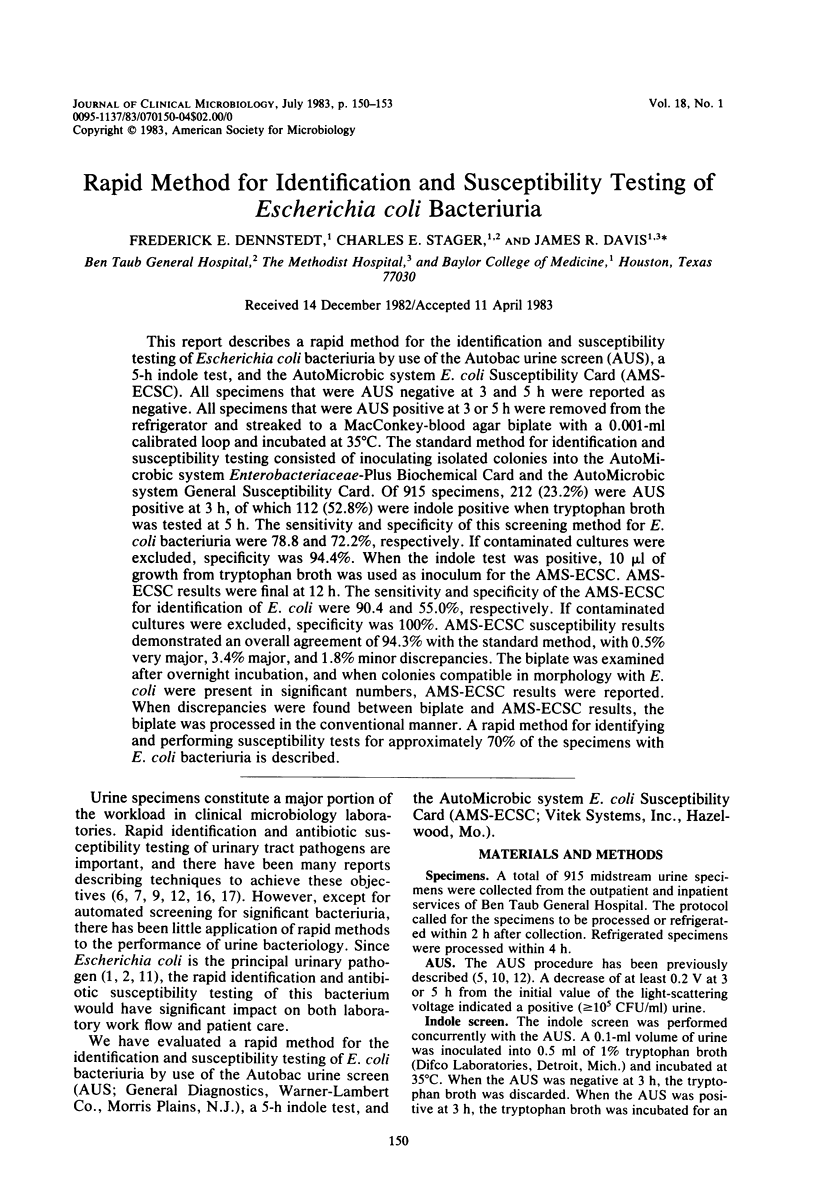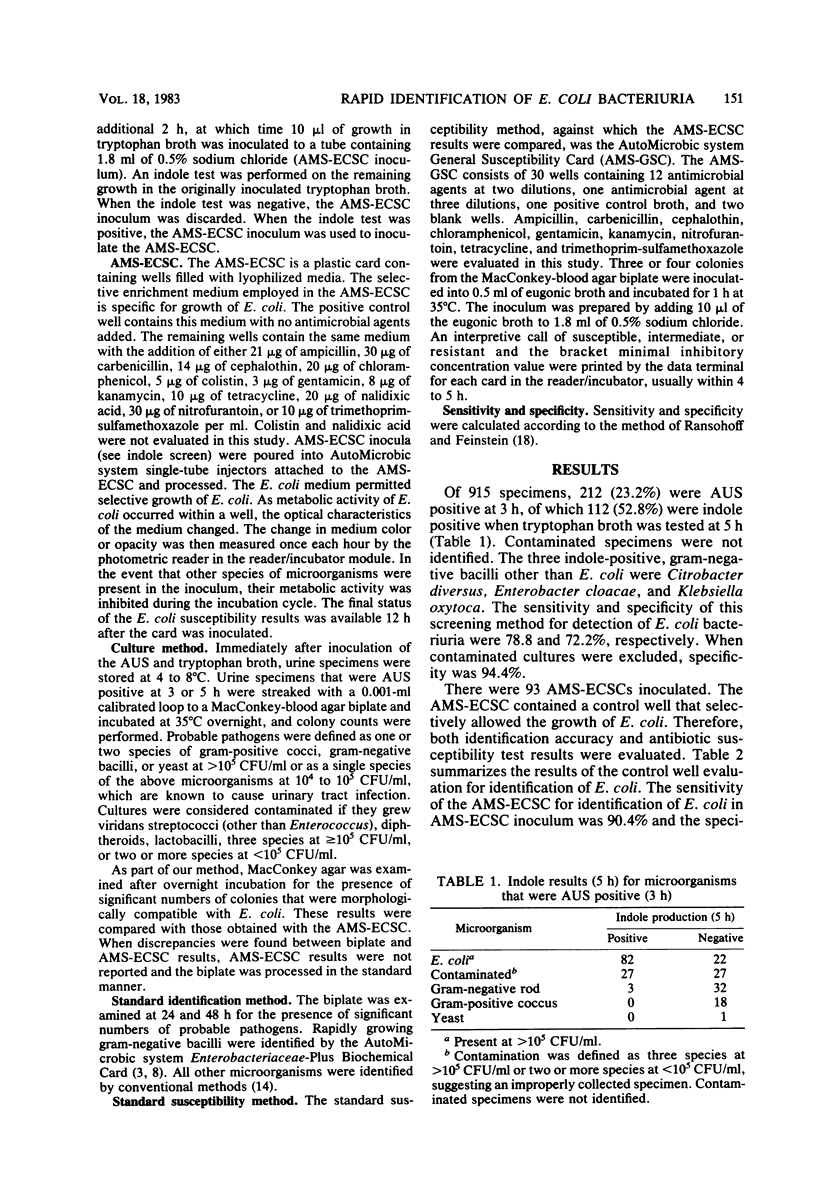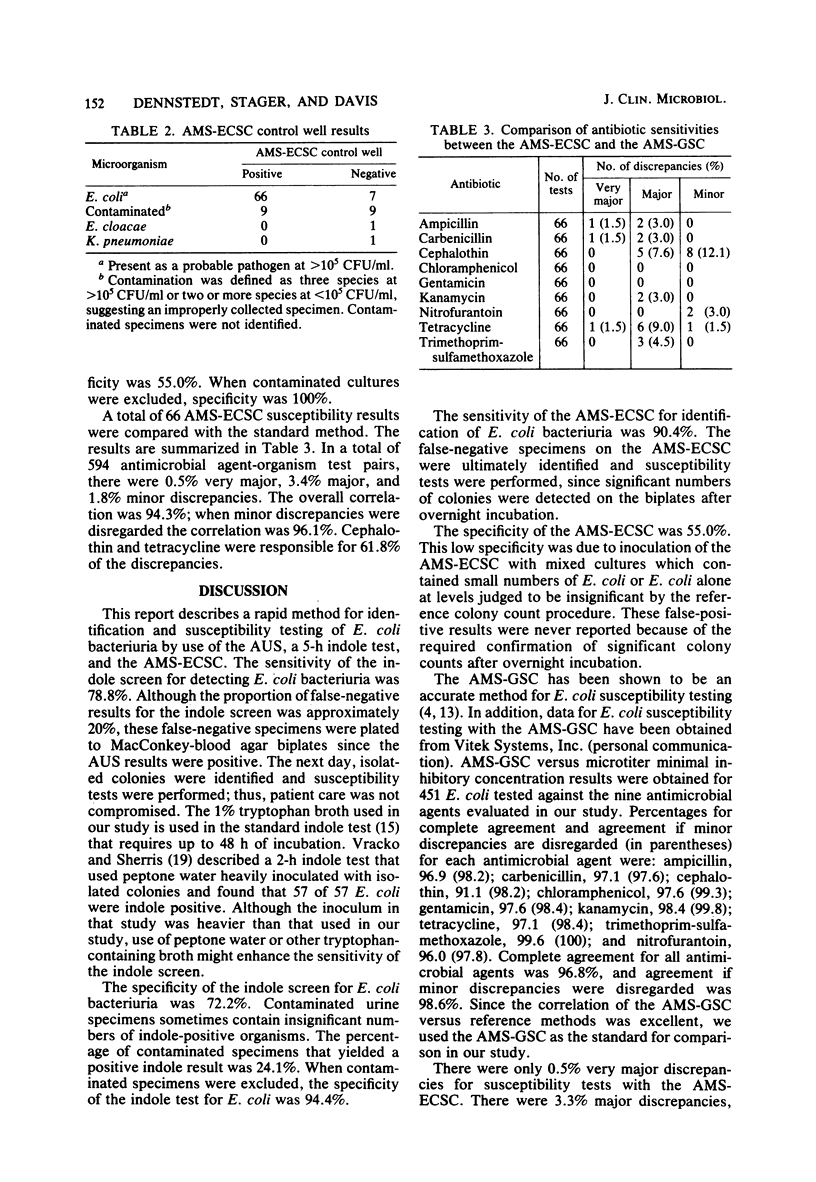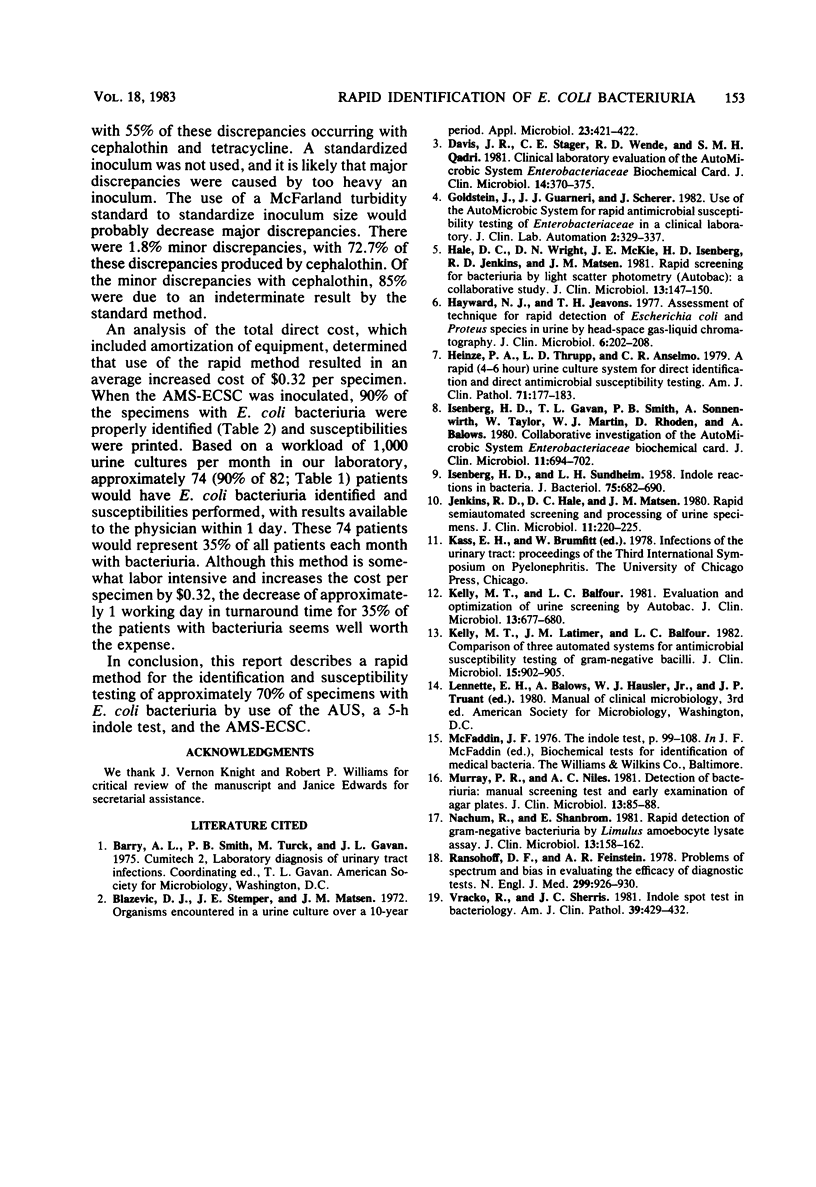Abstract
This report describes a rapid method for the identification and susceptibility testing of Escherichia coli bacteriuria by use of the Autobac urine screen (AUS), a 5-h indole test, and the AutoMicrobic system E. coli Susceptibility Card (AMS-ECSC). All specimens that were AUS negative at 3 and 5 h were reported as negative. All specimens that were AUS positive at 3 or 5 h were removed from the refrigerator and streaked to a MacConkey-blood agar biplate with a 0.001-ml calibrated loop and incubated at 35 degrees C. The standard method for identification and susceptibility testing consisted of inoculating isolated colonies into the AutoMicrobic system Enterobacteriaceae-Plus Biochemical Card and the AutoMicrobic system General Susceptibility Card. Of 915 specimens, 212 (23.2%) were AUS positive at 3 h, of which 112 (52.8%) were indole positive when tryptophan broth was tested at 5 h. The sensitivity and specificity of this screening method for E. coli bacteriuria were 78.8 and 72.2%, respectively. If contaminated cultures were excluded, specificity was 94.4%. When the indole test was positive, 10 microliters of growth from tryptophan broth was used as inoculum for the AMS-ECSC. AMS-ECSC results were final at 12 h. The sensitivity and specificity of the AMS-ECSC for identification of E. coli were 90.4 and 55.0%, respectively. If contaminated cultures were excluded, specificity was 100%. AMS-ECSC susceptibility results demonstrated an overall agreement of 94.3% with the standard method, with 0.5% very major, 3.4% major, and 1.8% minor discrepancies. The biplate was examined after overnight incubation, and when colonies compatible in morphology with E. coli were present in significant numbers, AMS-ECSC results were reported. When discrepancies were found between biplate and AMS-ECSC results, the biplate was processed in the conventional manner. A rapid method for identifying and performing susceptibility tests for approximately 70% of the specimens with E. coli bacteriuria is described.
Full text
PDF



Selected References
These references are in PubMed. This may not be the complete list of references from this article.
- Blazevic D. J., Stemper J. E., Matsen J. M. Organisms encountered in urine cultures over a 10-year period. Appl Microbiol. 1972 Feb;23(2):421–422. doi: 10.1128/am.23.2.421-422.1972. [DOI] [PMC free article] [PubMed] [Google Scholar]
- Davis J. R., Stager C. E., Wende R. D., Qadri S. M. Clinical laboratory evaluation of the automicrobic system Enterobacteriaceae biochemical card. J Clin Microbiol. 1981 Oct;14(4):370–375. doi: 10.1128/jcm.14.4.370-375.1981. [DOI] [PMC free article] [PubMed] [Google Scholar]
- Hale D. C., Wright D. N., McKie J. E., Isenberg H. D., Jenkins R. D., Matsen J. M. Rapid screening for bacteriuria by light scatter photometry (Autobac): a collaborative study. J Clin Microbiol. 1981 Jan;13(1):147–150. doi: 10.1128/jcm.13.1.147-150.1981. [DOI] [PMC free article] [PubMed] [Google Scholar]
- Hayward N. J., Jeavons T. H. Assessment of technique for rapid detection of Escherichia coli and Proteus species in urine by head-space gas-liquid chromatography. J Clin Microbiol. 1977 Sep;6(3):202–208. doi: 10.1128/jcm.6.3.202-208.1977. [DOI] [PMC free article] [PubMed] [Google Scholar]
- Heinze P. A., Thrupp L. D., Anselmo C. R. A rapid (4--6-hour) urine-culture system for direct identification and direct antimicrobial susceptibility testing. Am J Clin Pathol. 1979 Feb;71(2):177–183. doi: 10.1093/ajcp/71.2.177. [DOI] [PubMed] [Google Scholar]
- ISENBERG H. D., SUNDHEIM L. H. Indole reactions in bacteria. J Bacteriol. 1958 Jun;75(6):682–690. doi: 10.1128/jb.75.6.682-690.1958. [DOI] [PMC free article] [PubMed] [Google Scholar]
- Isenberg H. D., Gavan T. L., Smith P. B., Sonnenwirth A., Taylor W., Martin W. J., Rhoden D., Balows A. Collaborative investigation of the AutoMicrobic System Enterobacteriaceae biochemical card. J Clin Microbiol. 1980 Jun;11(6):694–702. doi: 10.1128/jcm.11.6.694-702.1980. [DOI] [PMC free article] [PubMed] [Google Scholar]
- Jenkins R. D., Hale D. C., Matsen J. M. Rapid semiautomated screening and processing of urine specimens. J Clin Microbiol. 1980 Mar;11(3):220–225. doi: 10.1128/jcm.11.3.220-225.1980. [DOI] [PMC free article] [PubMed] [Google Scholar]
- Kelly M. T., Balfour L. C. Evaluation and optimization of urine screening by Autobac. J Clin Microbiol. 1981 Apr;13(4):677–680. doi: 10.1128/jcm.13.4.677-680.1981. [DOI] [PMC free article] [PubMed] [Google Scholar]
- Kelly M. T., Latimer J. M., Balfour L. C. Comparison of three automated systems for antimicrobial susceptibility testing of gram-negative bacilli. J Clin Microbiol. 1982 May;15(5):902–905. doi: 10.1128/jcm.15.5.902-905.1982. [DOI] [PMC free article] [PubMed] [Google Scholar]
- Murray P. R., Niles A. C. Detection of bacteriuria: manual screening test and early examination of agar plates. J Clin Microbiol. 1981 Jan;13(1):85–88. doi: 10.1128/jcm.13.1.85-88.1981. [DOI] [PMC free article] [PubMed] [Google Scholar]
- Nachum R., Shanbrom E. Rapid detection of Gram-negative bacteriuria by Limulus amoebocyte lysate assay. J Clin Microbiol. 1981 Jan;13(1):158–162. doi: 10.1128/jcm.13.1.158-162.1981. [DOI] [PMC free article] [PubMed] [Google Scholar]
- Ransohoff D. F., Feinstein A. R. Problems of spectrum and bias in evaluating the efficacy of diagnostic tests. N Engl J Med. 1978 Oct 26;299(17):926–930. doi: 10.1056/NEJM197810262991705. [DOI] [PubMed] [Google Scholar]


